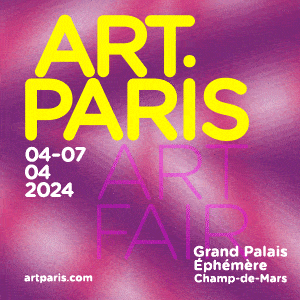Whitehot Magazine
April 2024
"The Best Art In The World"
"The Best Art In The World"
April 2024
March 2010, The Empire Strikes Back: Indian Art Today @ Saatchi Gallery

Reena Saini Kallat, Penumbra Passage (Canine Cases), 2006

Acrylic on canvas, bonded marble, wooden box, stainless steel, velvet, glass
Courtesy of the Saatchi Gallery, London
copyright Reena Sani Kallat, 2010
The Empire Strikes Back: Indian Art Today
Saatchi Gallery
Duke of York's HQ
King's Road
London
, SW3 4SQ
January 29 through May 7, 2010
The Saatchi Gallery, a stone’s throw from London’s chic Sloane Square in Chelsea, is nothing if not a stunning gallery. Relocated in October 2008 from the County Hall building in South London following the infamous fire in 2005, its new home is the 19th century Duke of York’s Headquarters, a remarkable 70,000 square feet worth of exhibition space, resting at the foot of an impeccably British green lawn. Tastefully renovated, with thirteen high-ceilinged, spacious gallery spaces, the Saatchi lends itself to large-scale sculptures and installations, and duly delivers with shows like Unveiled: New Art from the Middle East (30 January – 9 May 2009) and, most recently, with The Empire Strikes Back: Indian Art Today (29 January – 7 May 2010). All are curiously devoid of a specific curatorial concept, other than the objective of bringing certain contemporary artists from certain regions of the world to the UK.
Despite the gallery’s knack for selecting cringe-worthy exhibition titles rife with problematic connotations, it consistently brings individual gems to London audiences. At Unveiled, Kader Attia’s haunting installation Ghost (2007) stood out with its eerie shells of figures moulded from foil, bowing in the act, presumably, of prayer. At Indian Art Today, several works are distinct from the gratuitously disturbing pieces which simply reinforce Indian stereotypes and, more often than not, seem to have been selected because they cater to what a foreign audience expects from ‘Indian-ness’. The pieces by Jittish Kallat, Atul Dodiya, Reena Saini Kallat, and Pushpamala N and Clare Arni are compelling. They variously employ art as a tool for socio-political critique of Indian’s emergence into globalisation, as a means of exploring the impact of the country’s complex and traumatic history, as well as to provide sensitive assemblages of everyday life.
The first room is entirely dedicated to Mumbai-based Jitish Kallat’s Public Notice 2 (2007), a sculptural installation that covers the whole length and height of the left wall. 4500 off-white letters are set against a butterscotch yellow background. They carefully spell out the famous speech given by Mahatma Gandhi on the eve of his historic Salt March in 1930. Ominously opening with ‘In all probability this will be my last speech to you. Even if the Government allows me to march tomorrow morning...’, it calls for total civil disobedience whilst setting down the now legendary code of nonviolent conduct, stating that ‘[one] is vanquished only, when [one] forsakes truth and nonviolence’. At first glance, the letters appear merely curled in order to recall the Hindi alphabet. However, at closer inspection, the viewer is startled to observe that they are actually in the shape of bones, effectively tainting the very essence of Gandhi’s speech. By creating a paradoxical relic-alphabet, Kallat both subverts our romantic notions of Indian 20th century history and also exposes the tragic history of violence which plagued India in the following decades of civil unrest and war.

Jitish Kallat, Public Notice 2, 2007
Fibreglass sculptures, Dimensions variable
Courtesy of the Saatchi Gallery, London
copyright Jitish Kallat, 2010
Dodiya’s Portrait of Niko Pirosmani (1862-1918) (2005) is a touching homage to his late friend the painter Bhupen Khakhar, whom he believed was influenced by the Georgian primitivist painter Pirosmani. A careful assemblage, suggestive of a less exuberant and splattered Rauschenberg combine, it is composed of a stylistically primitivist enamel portrait of Pirosmani, carefully pasted onto a cotton kurta board, which is draped by a pair of pyjamas on metal hangars. The pyjamas are dyed black, a small tribute to Khakhar, who used to dye his black so he could wear them as aprons while painting in his studio. Dodiya’s work is not immediately striking nor does it call attention to itself. Like matured wine, it gradually grows on you, and the more it is observed and analysed the more one appreciates certain details and ultimately the whole. The same is true of his Fool’s House (2009). One might be tempted to immediately discard it as a simplistic and very belated nod to Jasper Johns, but attentive inspection and some knowledge of Dodiya’s own artistic career reveal a humorous, layered and creative homage to the iconic American painter. It prominently features a shuttered store, referring back to Dodiya’s own past as an artist who first gained acclaim by painting rolled down shutters, while also referencing his debt to Johns with a thin, easy-to-miss segment of a target. The whole comes neatly together with a painted ‘taped’ snapshot of Man Ray’s Cadeau, thus further establishing the painting as an offering to Johns.

Atul Dodiya, Portrait Of Niko Pirosmani (1862-1918), 2005

Enamel paint on laminate board, cotton kurta and cotton pyjamas on iron hangers
Courtesy of the Saatchi Gallery , London
copyright Atul Dodiya, 2010
Close by is Reena Saini Kallat’s compelling Penumbra Passage (Canine Cases) (2006), a set of two paintings accompanied by a pair of cases holding a range of weapons. Both paintings are captivating and realistically rendered, recalling European academic painting. The first depicts a gaunt, bearded, older man, in a three-quarter profile pose, his eyes downcast with a weary, almost resigned expression ridden with a troubling past. The second depicts an older woman, staring straight at us, likewise bearing a tired expression, her face eloquently speaking of a life which has beaten her down. Painted in monochromes of white, green and grey, the pieces are framed in intricately engraved steel frames, which are easily mistaken for silver given their grandiose appearance. The whole, however, is dramatically offset by a blemish hovering around the faces of the two characters, who we now learn are ordinary civilians from India and Pakistan, caught in a violent dispute between the two countries. The blemish is, in fact, a silhouette of Pakistan-occupied Kashmir painted alternately in blue and red, the only source of bright colour in the two paintings. Continuing to subvert the viewers’ expectations, Kallat positions a wooden case with a glass cover at the foot of each painting, where 32 white weapons are carefully arranged against a plush red velvet lining. It is a haunting and sensitive critique of conflict, bringing often-ignored victims of wars to the forefront – middle-aged and seemingly unwounded survivors, caught in a life gone horribly wrong.
Towards the very end of the show is the humorous and laborious piece by Bangalore-based photo and video-performance artists Pushpamala N and photographer Clare Arni - The Ethnographic Series Native American Women of South India: Manners & Customs (2000-2004). The two have created an impressive set of 46 engaging black and white photographs featuring Pushpamala as the subject (and therefore object), striking a number of different poses in a variety of costumes. In one shot, she is staring straight at the camera, wrapped in a white dress that exposes one shoulder, while a disembodied arm is holding a disturbing-looking device to measure her head; in another, she is seen full length, standing regally against a chequered background – evidently a studio – with her left arm held out at a right angle as it rests in yet another measuring tool. By wittily reconstructing the style of early anthropological photographic studies of indigenous populations, Pushpamala succeeds in both deconstructing ethnographic aims of ‘scientifically’ classifying human beings, as well as laying bare the limitations of photography and challenging the very authenticity of the photographic image, playing with notions of real and fake.

Pushpamala N and Clare Arni , Detail from the Ethnographic Series, 2000-2004
From the project: Native Women of South India (Manners & Customs)
Supported by an Arts Collaboration Grant from the India Foundation for the Arts
Set of 45 sepia-toned silver gelatin prints
Dimensions variable
Courtesy of the Saatchi Gallery, London
copyright Pushpamala N and Clare Arni, 2010

Ana Vukadin
Ana Vukadin is a regular contributor to murmurART and FAD. She completed her MA in History of Art from the Courtauld Institute of Art, London, specialising in modern and contemporary art.
view all articles from this author







